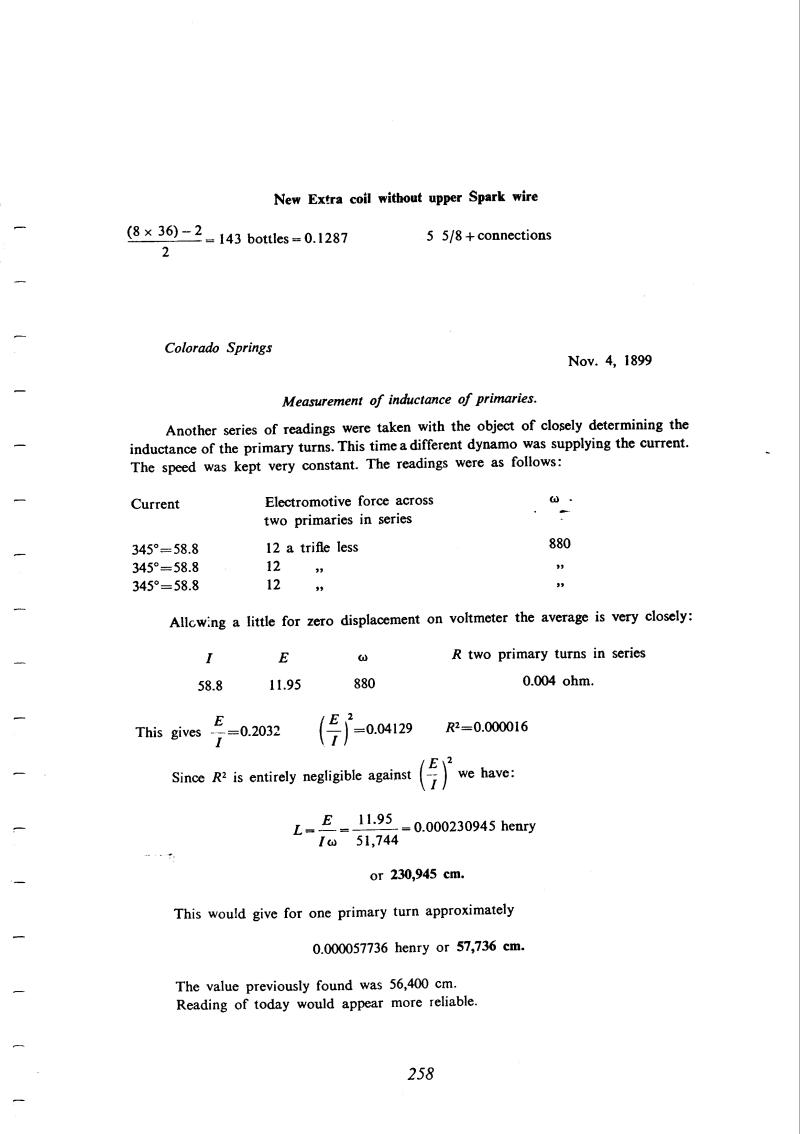
Nikola Tesla Books
New Extra coil without upper Spark wire
| $! {{\left({8 \times 36}\right) - 2} \over 2} $! = 143 bottles | =0.1287 | 5 5/8 + connections |
Colorado Springs
Nov. 4, 1899
Measurement of inductance of primaries.
Another series of readings were taken with the object of closely determining the inductance of the primary turns. This time a different dynamo was supplying the current. The speed was kept very constant. The readings were as follows:
| Current | Electromotive force across two primaries in series | Ï |
|---|---|---|
| 345° = 58.8 | 12 a trifle less | 880 |
| 345° = 58.8 | 12 " | " |
| 345° = 58.8 | 12 " | " |
Allowing a little for zero displacement on voltmeter the average is very closely:
| I | E | Ï | R two primary turns in series |
|---|---|---|---|
| 58.8 | 11.95 | 880 | 0.004 ohm. |
This gives $! {E \over I} $! = 0.2032 $! {\left({E \over I}\right)^{2}} $! = 0.04129 R2 = 0.000016
Since R2 is entirely negligible against $! {\left({E \over I}\right)^{2}} $! we have:
$! {L = {E \over I Ï} = {11.95 \over 51,744}} $! = 0.000230945 henry
or 230,945 cm.
This would give for one primary turn approximately
0.000057736 henry or 57,736 cm.
The value previously found was 56,400 cm.
Reading of today would appear more reliable.
258
November 3
A repeated measurement of the capacity of the vertical wire and the 30" sphere by the method of October 29th but with a new coil L (see October 31st). A new feature is Teslaâs attempt to eliminate the wires of the spark gap, estimating the excitation solely from the streamers.
November 3
He measures the capacitance of the vertical wire and sphere of 30" in diameter again by following the method of Oct. 29 but with new coil L (please see Oct. 31). that he attempts to eliminate the wires of the measuring arc gap and that for pose of finding the resonance he uses the current streamers indication.
November 4-5
He measures the oscillator primary inductance again with a new supply source. The obtained result he compares with the previous one, probably with the one of Sept. 25. He draws the conclusion that new result is more reliable. On photographs of Tesla's laboratory in Colorado Springs the pole which is in the middle of the laboratory could always be seen. The geometrical dimensions of this pole are given in the notes of Oct. 17. On Nov. 5 he calculates the capacitance of the sum mid pole sections. He considers that the total capacitance is the sum of the capacitances of the individual portions of various diameters of the pole. When calculating he applies the equation given the first time on Oct. 28. Finally at the end of the calculation he gives an interesting comment which illustrates how deeply he got into the physical essence of the event.

